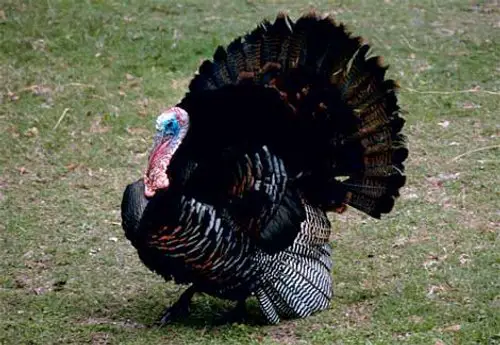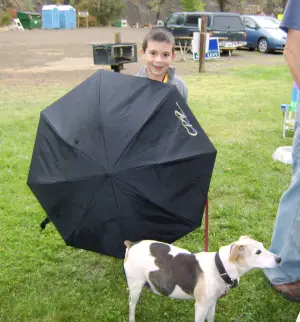
Indigenous to the Americas, the wild turkey is a majestic, fast-running bird more of interest to bird watchers and hunters than butchers.
The wild turkey was domesticated around 10 BC to 10 A D by the Aztecs. They ate its meat and used its feathers for ornamental purposes during their annual turkey festival. They were known to trade about 1,000 birds daily in their markets. When the conquistadors arrived in the Americas, turkey had become the staple meat of Mayans, Aztecs, Incas and other indigenous peoples.
In the wild the bird is fast (up to 40 kilometer per hour top speed), and its eyesight and hearing are sharp. Some say the bird is unattractive looking, but the male has an iridescent plumage that is fine to look at when he “displays” the ruffled feathers.
The bird sports a fanlike tail, bare head and bright beard. They gobble with a distinctive sound that can be heard a mile and a half away. During the day wild turkeys forage for seeds, berries, buds and grubs (even a little snake, frog or salamander may be on its menu), and at night they fly into trees to roost. An adult wild turkey can weigh as much as 20 pounds and they can live to be 6 to 9 years old.
The females will lay four to 17 eggs, and feed their chicks for a few days after they hatch and the males take no role in the raising of the young. That is why you will often see mother/child flocks that can number in the dozens.
Benjamin Franklin would have preferred that the wild turkey be the national bird of the US instead of the bald eagle.
Writing to his daughter he stated: “For my own part I wish the Bald Eagle had not been chosen the representative of our Country. For the truth the Turkey is in comparison a much more respectable bird, and withal a true original Native of America ... He is besides, though a little vain & silly, a Bird of Courage, and would not hesitate to attack a Grenadier of the British Guards who should presume to invade his Farm Yard with a red coat on.”
The wild turkey was wiped out in the United States by overhunting coupled with the disappearance of their preferred woodland habitat in the early 20th century.
They will typically forage on forest floors, but can also be found in grasslands and swamps. You can see them foraging in open areas around Davis and Woodland, in the farm lands and around Cache Creek, and throughout Lake County. Feeding on nuts, seeds, fruits, insects, and salamanders they can be both beneficial and a pest to the gardener or farmer and to the declining salamander population.
In the 1940s, reintroduction programs of the wild bird took place and the birds were relocated to areas where populations had been decimated but woodlands were recovering. The program was so successful the birds now live in areas where they may not have occurred when Europeans first reached the Americas. Today, flocks can be found in Hawaii, Europe and New Zealand.

Now occupying about 18 percent of our state they are a highly valued upland game bird as well as a great bird to watch.
If you have the birds around your home or farm it is best to resist feeding them or approaching them. Trouble can begin as a flock of wild turkeys can cause great damage to a garden and if they lose their natural fear of humans they could become dangerously aggressive during breeding season.
If you have a problem with wild turkeys contact your local Department of Fish and Game office or visit www.dfg.ca.gov/regulations .
Mayan royal feasts included turkey wrapped in corn tortillas. Heat a corn tortilla until soft; add warm shredded turkey, a bit if avocado and if you are as courageous as the wild turkey a bit of habanera chili. Roll up and enjoy with steamed wild rice and fresh tomatoes.
For a more adventurous use of your leftover turkey you might try this tamale recipe called “Pibikutz, adapted from a recipe in the Diario Yucatan the Merida Yucatan newspaper, October 1996.
Traditionally prepared during the festival of Hanal Pixan, which has since become the Day of the Dead in the Maya area, this dish has a symbolic process of "burying" the tamale in a pit and then "resurrecting" as it corresponds with the ancient Maya idea of burying the dead before their transition into the afterlife.
4 cups turkey broth
6 2/3 cups corn masa harina
1/3 cup solid turkey fat or butter
6 2/3 cups shredded cooked turkey (for a vegetarian version substitute thinly sliced “ToFurkey”)
1 teaspoon achiote
Salt, to taste
1 cup tomato
1 large onion
2 sprigs of epazote (parsley is a close substitute)
habanera chile, to taste
about 12-15 corn husks
Boil the broth with half a teaspoon of achiote or parsley, a dash of salt and a little bit of the masa harina for thickening. This will be part of the "kol" that bathes the interior of the tamales.
Mix the corn masa with the turkey fat, salt and achiote to make a dough. This forms the filling that will cover the shredded turkey meat. Put some of this corn dough on top of a corn husk. Make a hollow in the dough. Layer this hollow with the turkey and bathe with the broth, alternating with onion, tomato, chile and epazote. Finally, put a covering of corn dough on top.
Wrap everything with corn husks and then bake for an hour and a half at 375 degrees. Or, for the traditional method, bury the pibikutz in a firewood and rock pit, and let cook for eight hours. Truly a “wild” treat!
Debra Chase is the executive director of Tuleyome, a local nonprofit working to protect both our wild heritage and our agricultural heritage for future generations. She's also the chef/owner of UnCooked Creations, a raw vegan/vegetarian professional chef service. She and her husband Dave reside on their farm in Colusa County. Visit Tuleyome online at www.tuleyome.org .
Follow Lake County News on Twitter at http://twitter.com/LakeCoNews and on Facebook at http://www.facebook.com/pages/Lake-County-News/143156775604?ref=mf .
